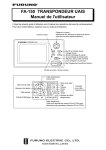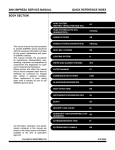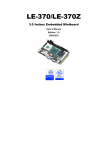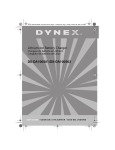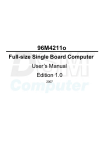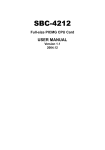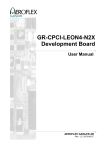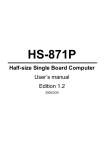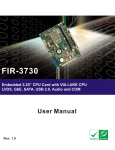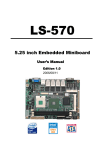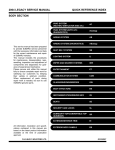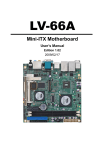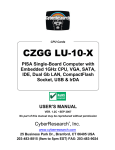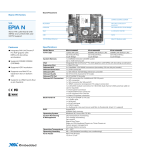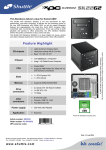Download User`s manual
Transcript
EE-260 VIA ETX Motherboard User’s Manual Edition 1.0 2008/05/14 EE-260 User’s Manual Copyright Copyright 2006. All rights reserved. This document is copyrighted and all rights are reserved. The information in this document is subject to change without prior notice to make improvements to the products. This document contains proprietary information and protected by copyright. No part of this document may be reproduced, copied, or translated in any form or any means without prior written permission of the manufacturer. All trademarks and/or registered trademarks contains in this document are property of their respective owners. Disclaimer The company shall not be liable for any incidental or consequential damages resulting from the performance or use of this product. The company does not issue a warranty of any kind, express or implied, including without limitation implied warranties of merchantability or fitness for a particular purpose. The company has the right to revise the manual or include changes in the specifications of the product described within it at any time without notice and without obligation to notify any person of such revision or changes. Trademark All trademarks are the property of their respective holders. Any questions please visit our website at http://www.commell.com.tw TU 2 UT EE-260 User’s Manual Packing List Please check the package before you starting setup the system Hardware: EE-260 ETX CPU Module x 1 Cable Kit: 26-pin slim type floppy cable x 1 Serial ATA ribbon cable x 2 Head Sink and four screws Other Accessories: Divers CD (including User’s Manual) x 1 3 EE-260 User’s Manual Index Chapter 1 <Introduction> ..................................................................................... 7 1.1 <Product Overview>................................................................................. 7 1.2 <Product Specification> ........................................................................... 8 1.3 <Mechanical Drawing>........................................................................... 10 1.4 <Block Diagram>.................................................................................... 11 Chapter 2 <Hardware Setup>............................................................................. 12 2.1 <Connector Location>............................................................................ 12 2.2 <Connector Reference>......................................................................... 13 2.2.1 <Internal Connector>.................................................................. 13 2.3 <CPU and Memory Setup> .................................................................... 14 2.3.1< CPU>........................................................................................ 14 2.3.2 <Memory> .................................................................................. 14 2.4 <Enhanced IDE & CF Interface>............................................................ 15 2.5 <Serial ATA Interface>........................................................................... 15 2.6 <Floppy Port>......................................................................................... 16 2.7 <LAN Interface> ..................................................................................... 17 2.8 <Onboard Display Interface> ................................................................. 17 2.8.1 <Analog VGA Interface> ............................................................ 17 2.9 <USB2.0 & IEEE1394 Interface> ........................................................... 18 2.10 <Serial Port> ........................................................................................ 18 Chapter 3 <System Configuration>................................................................... 19 3.1 <SATA RAID Configuration>.................................................................. 19 3.2 <Audio Configuration> ........................................................................... 21 3.3 <Display Configuration>......................................................................... 22 Chapter 4 <BIOS Setup> .................................................................................... 25 Appendix A <ETX connector Assignment>……………………………………….27 Appendix B <I/O Port Pin Assignment> ........................................................... 31 4 EE-260 User’s Manual B.1 <Floppy Port> ........................................................................................ 31 B.2 <Serial ATA Port>................................................................................... 31 Appendix C <Flash BIOS>.................................................................................. 33 C.1 BIOS Auto Flash Tool ...................................................................... 33 C.2 Flash Method................................................................................... 33 Contact Information ............................................................................................ 35 5 EE-260 User’s Manual (The Page is Left For Blank) 6 EE-260 User’s Manual Introduction Chapter 1 <Introduction> 1.1 <Product Overview> EE-260 is the ETX module based on VIA Luke CoreFusion TM Processor. It integrates the VIA embedded Luke Processor with VT8237R+, DDR SoDimm SDRAM, and serial ATA with RAID to provide the economical embedded platform. VIA Luke CoreFusion TM Processor & VT8237R+ The board comes with the VIA embedded processor Luke DDR266/333/400 SoDimm integrated the S3 Graphics UniChrome Pro IGP graphics core ,hardware MPEG-2 and MPEG-4 acceleration . The VT8237R+ provides the board to support Ultra V-Link (1GB/s) , two serial ATA ports with RAID array function, Support 4 x USB2.0 ports and Realtek ALC202A 2 channel audio. Multimedia solution Based on VIA CoreFusion TM Processor, the module provides optional 18/24-bit LVDS interface, which supports dual independent display with CRT. High Speed Hot-plug Interface Based on VIA VT8237R+, the board support 4 USB2.0 interfaces with up to 480Mbps of transferring rate. Product Overview 7 EE-260 User’s Manual Introduction 1.2 <Product Specification> General Specification Form Factor CPU Memory Chipset BIOS Green Function Watchdog Timer Real Time Clock Enhanced IDE Serial ATA ETX CPU Module TM Embedded VIA Luke CoreFusion processor Ratio: 533MHz/800MHz/1GHz Front side bus: 133MHz Fanless with Luke 533MHz processor 1 x 200-pin DDR SoDIMM SDRAM up to 1GB Unbufferred, none-ECC memory supported only TM VIA CoreFusion and VT8237R+ Phoenix-Award v6.00PG 4Mb PnP flash BIOS Power saving mode includes doze, standby and suspend modes. ACPI version 1.0 and APM version 1.2 compliant System reset programmable watchdog timer with 1 ~ 255 sec./min. of timeout value VIA VT8237R+ built-in RTC with lithium battery Support two channels & up to four IDE device Support Ultra DMA 33 IDE device VIA VT8237R+ integrates 2 Serial ATA interface RAID 0, 1 array Technology supported Multi-I/O Port Chip Serial Port USB Port Floppy Port IrDA Port K/B & Mouse GPIO Hardware Monitor Winbond W83697HG controller Support two RS232 Serial Port Support four USB 2.0 Ports Onboard slim type Floppy connector Support IrDA compliant Infrared interface supports SIR Support external PS/2 keyboard and mouse ports 8-bit programmable I/O interface CPU temperature and voltage monitoring VGA Display Interface Chipset Core Frequency Memory Display Type 8 TM VIA Luke Processor CoreFusion built-in S3 Graphics UniChrome Pro IGP graphics core 200MHz BIOS selectable 16/32/64MB shard with system memory Support CRT, LCD monitor with analog display Product Specification EE-260 User’s Manual Introduction Optional LVDS Interface Chip Resolution VT1631L Support 18/24bit dual channel 1600 x 1200 resolution Ethernet Interface Chip Type VIA VT6103 PHY 10Base-T / 100Base-TX auto-switching Fast Ethernet Full duplex, IEEE802.3U compliant Audio Interface Chip Interface Realtek ALC202A Support Line-in, Line-out and MIC-in Expansive Interface PCI 4 PCI bus master interface Power and Environment Power Requirement Dimension Temperature 5V/3.2A, 5Vstandby/ 95mm x 114mm Operating within 0 ~ 60oC (32 ~ 140oF) Storage within -20 ~ 85oC (-4 ~ 185oF) P P P P P P P P Software support Operation System Windows 98SE/ME, Windows 2000, Windows XP Windows CE 4.0 or later, Windows XP Embedded Linux (Fedora Core 1, Mandrake 9.2 and Red Hat 9.0) Ordering Code EE-260L5 EE-260L8 EE-260L10 TM SOM-ETX with VIA Luke CoreFusion processor 533MHz/VGA/LVDS/LAN/Audio/SATA TM SOM-ETX with VIA Luke CoreFusion processor 800MHz/VGA/LVDS/LAN/Audio/SATA TM SOM-ETX with VIA Luke CoreFusion processor 1GHz/VGA/LVDS/LAN/Audio/SATA 1. The specifications may be different as the actual production. For further product information please visit the website at http://www.commell.com.tw TU Product Specification UT 9 EE-260 User’s Manual Introduction 1.3 <Mechanical Drawing> 10 Product Specification EE-260 User’s Manual Introduction 1.4 <Block Diagram> CRT/LCD Monitor 1 x 200-pin SoDIMM Optional LVDS DDR266/333/400 Ultra V-Link 1GB/s 4 x USB2.0 Ports Up to 1GB 2 x SATA VT6103 PHY VT8237R+ PCI ALC202 Codec 2 x Serial ports 1 x Floppy ports 8-bit GPIO BIOS IrDA LPT Product Specification 11 EE-260 User’s Manual Introduction Chapter 2 <Hardware Setup> 2.1 <Connector Location> DIMM SATA 12 FDD Product Specification EE-260 User’s Manual Hardware Setup 2.2 <Connector Reference> 2.2.1 <Internal Connector> Connector DIMM FDD CN_SATA1/2 Connector Location Function 200-pin DDR SDRAM SoDIMM 26-pin slim type floppy connector 7-pin Serial ATA connector Remark Standard Standard Standard 13 EE-260 User’s Manual Introduction 2.3 <CPU and Memory Setup> 2.3.1< CPU> The board supports Embedded VIA Luke CoreFusion TM processor, default ratio is 533Mhz/800Mhz/1GHz with CPU cooler fan, Luke 533 (533MHz) with heatsink only. 2.3.2 <Memory> The board supports one 200-pin DDR SoDIMM SDRAM and up to 1GB of capacity, only non-ECC, unbuffered memory is supported. DIMM (1. Insert the DDR SO-DIMM module into the socket at 45 degree) (2. Press down the module with a click sound) 14 CPU and Memory Setup EE-260 User’s Manual Hardware Setup 2.4 <Enhanced IDE & CF Interface Optional > The module supports two enhanced IDE interface, dual channel for 4 ATAPI devices with ATA33. 2.5 <Serial ATA Interface> Based on VIA VT8237R+ Southbridge, the board supports two Serial ATA interfaces with RAID 0 and 1 array function. The following is the list of the specification of the Serial ATA. 1. Complies with Serial ATA Specification Revision 1.0 2. Dual Channel master mode PCI 3. On-chip two-channel Serial ATA (S-ATA) PHY for support of up to two S-ATA devices directly. 4. S-ATA drive transfer rate is capable of up to 150 MB/s per channel (serial speed of 1.5 Gbit/s). For more information please visit VIA website (www.via.com.tw) SATA2 Serial ATA Interface SATA1 15 EE-260 User’s Manual Introduction 2.6 <Floppy Port> The board provides a slim type floppy port; please use the 26-pin ribbon cable in the package to connect the floppy device. FDD Floppy rear side 4. 16 1. Lift up this plastic bar 2. Slot the cable in (Blue paste for outside) 3. Press back the plastic bar Lift up the brown plastic bar 5. Slot the cable in (Blue paste for 6. brown bar side) Press back the plastic bar Floppy Port EE-260 User’s Manual Hardware Setup 2.7 <LAN Interface> The board provides 10/100Mbps LAN interfaces with VIA VT6103 PHY PCI controller, and compliant with standard IEEE 802.3 Ethernet interface for 100BASE-TX. 2.8 <Onboard Display Interface> Based on VIA Luke CoreFusion TM processor, the module supports integrated S3 Graphics UniChrome Pro IGP graphics, with BIOS selectable 16/32/64MB shared with system memory for frame buffer. 2.8.1 <Analog VGA Interface> The module provides a DB15 VGA connector up to 1920 x 1400 dpi on the rear I/O panel. Onboard Audio Interface 17 EE-260 User’s Manual 2.9<USB2.0 & IEEE1394 Interface> Based on VIA VT8237R+, the board provides 4 USB2.0 ports.The USB2.0 interface provides up to 480Mbps of transferring rate. Interface USB2.0 Controller VIA VT8237R+ Transfer Rate Up to 480Mb/s PS: The USB2.0 will be only active when you connecting with the USB2.0 devices, if you insert an USB1.1 device, the port will be changed to USB1.1 protocol automatically. The transferring rate of USB2.0 as 480Mbps is depending on device capacity, exact transferring rate may not be up to 480Mbps. 2.10 <Serial Port> The board provides two RS232 serial ports. (This Page is Left For Blank) 18 EE-260 User’s Manual System Configuration Chapter 3 <System Configuration> 3.1 <SATA RAID Configuration> The board supports two Serial ATA ports onboard, and supports RAID 0, 1 and JBOD disk array, the RAID 0, 1 and JBOD are specified below: RAID 0 (Stripping): Two hard drives operating as one drive for optimized data R/W performance. It needs two unused drives to build this operation. RAID 1 (Mirroring): Copies the data from first drive to second drive for data security, and if one drive fails, the system would access the applications to the workable drive. It needs two unused drives or one used and one unused drive to build this operation. The second drive must be the same or lager size than first one. JBOD (Span): As different as RAID 0, the JBOD combines two disks as one without any fault tolerance and I/O performance enhancement. To build Serial ATA disk array, please press <TAB> while booting up the system before entering OS, and follow the instructions to edit the RAID function. (Selectable Functions) (Option Instruction) (Disk Statement) SATA RAID Configuration 19 EE-260 User’s Manual System Configuration You also can edit disk array under OS, please install the VIA RAID Utility in the driver CD. (To getting start, please click here to learn more information) (Click here to build RAID 0) (Click here to build RAID JBOD) (Click here to build RAID 0) 20 SATA RAID Configuration EE-260 User’s Manual System Configuration 3.2 <Audio Configuration> The board provides 2 channel audio interface with driver installed, please install the VIA audio driver in the CD before getting start to enjoy the 2 channel sound system. Audio Configuration 21 EE-260 User’s Manual System Configuration 3.3 <Display Configuration> The board provides onboard analog VGA interface, and optional digital display interface with LVDS , please install the VIA video driver before enjoy the vivid display. Based on the VIA Luke with S3 UniChrome Pro graphic, the board provides dual display function for clone or extended desktop modes with secondary display device attached. After installing video driver, please launch the desktop display properties. Please select each device to configure the resolution and color bit. For secondary display device, you have two options selectable. For more display properties setting, please click “Advanced” button. 22 Display Configuration EE-260 User’s Manual System Configuration Please select S3Display for advanced device setting. Connected Devices Click check box to enable/disable device Specified display setup When you set dual display clone mode, you’ll see the same screen display on two devices. When you set the dual display for extended desktop mode, you can have the independent desktop on the second device. Display Configuration 23 EE-260 User’s Manual (This Page is Left for Blank) 24 EE-260 User’s Manual BIOS Setup Chapter 4 <BIOS Setup> The motherboard uses the Award BIOS for the system configuration. The Award BIOS in the single board computer is a customized version of the industrial standard BIOS for IBM PC AT-compatible computers. It supports Intel x86 and compatible CPU architecture based processors and computers. The BIOS provides critical low-level support for the system central processing, memory and I/O sub-systems. The BIOS setup program of the single board computer let the customers modify the basic configuration setting. The settings are stored in a dedicated battery-backed memory, NVRAM, retains the information when the power is turned off. If the battery runs out of the power, then the settings of BIOS will come back to the default setting. The BIOS section of the manual is subject to change without notice and is provided here for reference purpose only. The settings and configurations of the BIOS are current at the time of print, and therefore they may not be exactly the same as that displayed on your screen. To activate CMOS Setup program, press <DEL> key immediately after you turn on the system. The following message “Press DEL to enter SETUP” should appear in the lower left hand corner of your screen. When you enter the CMOS Setup Utility, the Main Menu will be displayed as Figure 4-1. You can use arrow keys to select your function, press <Enter> key to accept the selection and enter the sub-menu. Figure 4-1 CMOS Setup Utility Main Screen BIOS Setup 25 EE-260 User’s Manual (This Page is Left for Blank) 26 EE-260 User’s Manual Appendix A <ETX connector Assignment> Connector A A1 GND A2 GND A51 VCC A52 VCC A3 PCICLK5 A4 PCICLK6 A53 PAR A54 -SERR A5 GND A6 GND A55 -GPERR A56 N/C A7 PCICLK1 A8 PCICLK2 A57 -PME A58 -USB2 A9 -REQ3 A10 -GNT3 A59 -LOCK A60 -DEVSEL A11 -GNT2 A12 +3.3V A61 -TRDY A62 -USB3 A13 -REQ2 A14 -GNT1 A63 -IRDY A64 -STOP A15 -REQ1 A16 +3.3V A65 -FRAME A66 +USB2 A17 -GNT0 A18 N/C A67 GND A68 GND A19 VCC A20 VCC A69 AD16 A70 -CBE2 A21 SERIRQ A22 -REQ0 A71 AD17 A72 +USB3 A23 AD0 A24 +3.3V A73 AD19 A74 AD18 A25 AD1 A26 AD2 A75 AD20 A76 USB- A27 AD4 A28 AD3 A77 AD22 A78 AD21 A29 AD6 A30 AD5 A79 AD23 A80 -USB1 A31 -CBE0 A32 AD7 A81 AD24 A82 -CBE3 A33 AD8 A34 AD9 A83 VCC A84 VCC A35 GND A36 GND A85 AD25 A86 AD26 A37 AD10 A38 AUXAL A87 AD28 A88 +USB0 A39 AD11 A40 MIC A89 AD27 A90 AD29 A41 AD12 A42 AUXAR A91 AD30 A92 +USB1 A43 AD13 A44 N/C A93 -PCIRST A94 AD31 A45 AD14 A46 SNDL A95 -INTRC A96 -INTRD A47 AD15 A48 ASGND A97 -INTRA A98 -INTRB A49 -CBE1 A50 SNDR A99 GND A100 GND 27 EE-260 User’s Manual Connector B B1 GND B2 GND B51 VCC B52 VCC B3 LGP0 B4 N/C B53 N/C B54 N/C B5 LGP1 B6 N/C B55 N/C B56 N/C B7 LGP2 B8 N/C B57 N/C B58 N/C B9 LGP3 B10 N/C B59 N/C B60 N/C B11 LGP4 B12 N/C B61 N/C B62 N/C B13 LGP5 B14 N/C B63 N/C B64 N/C B15 LGP6 B16 N/C B65 N/C B66 N/C B17 N/C B18 N/C B67 GND B68 GND B19 N/C B20 N/C B69 N/C B70 N/C B21 LGP7 B22 N/C B71 N/C B72 N/C B23 N/C B24 N/C B73 N/C B74 N/C B25 N/C B26 N/C B75 N/C B76 N/C B27 N/C B28 N/C B77 N/C B78 N/C B29 N/C B30 N/C B79 N/C B80 N/C B31 N/C B32 N/C B81 N/C B82 N/C B33 N/C B34 N/C B83 VCC B84 VCC B35 GND B36 GND B85 N/C B86 N/C B37 N/C B38 N/C B87 N/C B88 N/C B39 N/C B40 N/C B89 N/C B90 N/C B41 N/C B42 N/C B91 N/C B92 N/C B43 N/C B44 N/C B92 N/C B94 N/C B45 N/C B46 N/C B95 N/C B96 N/C B47 N/C B48 N/C B97 N/C B98 N/C B49 N/C B50 N/C B99 GND B100 GND 28 IDE Port EE-260 User’s Manual Connector C C1 GND C2 GND C51 LPT C52 N/C C3 AR C4 AB C53 VCC C54 GND C5 HSYNC C6 AG C55 -STB C56 -AFD C7 VSYNC C8 SPCLK2 C57 N/C C58 PD7 C9 -DETEC C10 SPD2 C59 IRRX C60 -ERR C11 CLK2M C12 A7M C61 IRTX C62 PD6 C13 CLK2P C14 A7P C63 RXD2 C64 -INIT C15 GND C16 GND C65 GND C66 GND C17 A5P C18 A6P C67 -RTS2 C68 PD5 C19 A5M C20 A6M C69 -DTR2 C70 -SLIN C21 GND C22 GND C71 -DCD2 C72 PD4 C23 A3M C24 A4P C73 -DSR2 C74 PD3 C25 A3P C26 A4M C75 -CTS2 C76 PD2 C27 GND C28 GND C77 TD2 C78 PD1 C29 A2M C30 CLK1P C79 -RI2 C80 PD0 C31 A2P C32 CLK1M C81 VCC C82 VCC C33 GND C34 GND C83 RD1 C84 -ACK C35 A0P C36 A1P C85 -RTS1 C86 BUSY C37 A0M C38 A1M C87 -DTR1 C88 PE C39 VCC C40 VCC C89 -DCD1 C90 SLCT C41 N/C C42 N/C C91 -DSR1 C92 MSCLK C43 N/C C44 INV ON C93 -CTS1 C94 MSDAT C45 N/C C46 AVDDCTL C95 TD1 C96 KBCLK C47 N/C C48 N/C C97 -RL1 C98 KBDATA C49 N/C C50 N/C C99 GND C100 GND 29 EE-260 User’s Manual Connector D D1 GND D2 GND D51 -SDIOW D52 -PDIOR D3 5V_SB D4 PWRGD D53 SDDREQ D54 -PDIOW D5 PS_ON D6 SYSPKR D55 SDD15 D56 PDDREQ D7 PW_BN D8 BATT D57 SDD0 D58 PDD15 D9 N/C D10 N/C D59 SDD14 D60 PDD0 D11 N/C D12 -ACT D61 SDD1 D62 PDD14 D13 N/C D14 -SP100 D63 SDD13 D64 PDD1 D15 N/C D16 N/C D65 GND D66 GND D17 VCC D18 VCC D67 SDD2 D68 PDD13 D19 -OC0 D20 N/C D69 SDD12 D70 PDD2 D21 -EXTSMI D22 N/C D71 SDD3 D72 PDD12 D23 SMBCLK D24 SMBDATA D73 SDD11 D74 PDD3 D25 -SCS3 D26 N/C D75 SDD4 D76 PDD11 D27 -SCS1 D28 -HDLED2 D77 SDD10 D78 PDD4 D29 SDA2 D30 -PCS3 D79 SDD5 D80 PDD10 D31 SDA0 D32 -PCS1 D81 VCC D82 VCC D33 GND D34 GND D83 SDD9 D84 PDD5 D35 -LID D36 PDA2 D85 SDD6 D86 PDD9 D37 SDA1 D38 PDA0 D87 SDD8 D88 PDD6 D39 IRQ15 D40 PDA1 D89 -RING D90 GPI1 D41 -BATLOW D42 N/C D91 RD- D92 PDD8 D43 -SDDACK D44 IRQ14 D93 RD+ D94 SDD7 D45 SHDRDY D46 PDDACK D95 TD- D96 PDD7 D47 -SDIOR D48 PHDRDY D97 TD+ D98 -IDERST D49 VCC D50 VCC D99 GND D100 GND 30 IDE Port EE-260 User’s Manual Appendix B<I/O Port Pin Assignment> B.1 <Floppy Port> Connector: FDD Type: 26-pin connector Pin Description 1 VCC 3 VCC 5 VCC 7 DRV1 9 MTR1 11 RPM 13 N/C 15 Ground 17 Ground 19 N/C 21 N/C 23 Ground 25 Ground Pin 2 4 6 8 10 12 14 16 18 20 22 24 26 Description INDEX DRV0 DSKCHG N/C MTR0 DIR STEP WRITE DATA WRITE GATE TRACK 0 WRPTR RDATASEL B.2 <Serial ATA Port> Connector: CN_SATA1/2 Type: 7-pin wafer connector 1 2 3 4 5 6 7 GND RSATA_TXP1 RSATA_TXN1 GND RSATA_RXN1 RSATA_RXP1 GND 31 EE-260 User’s Manual (This Page is Left for Blank) 32 EE-260 User’s Manual Appendix C <Flash BIOS> C.1 BIOS Auto Flash Tool The board is based on Award BIOS and can be updated easily by the BIOS auto flash tool. You can download the tool online at the address below: http://www.award.com http://www.commell.com.tw/support/support.htm TU UT TU UT File name of the tool is “awdflash.exe”, it’s the utility that can write the data into the BIOS flash ship and update the BIOS. C.2 Flash Method 1. Please make a bootable floppy disk. 2. Get the last .bin files you want to update and copy it into the disk. 3. Copy awardflash.exe to the disk. 4. Power on the system and flash the BIOS. (Example: C:/ awardflash XXX.bin) 5. Re-star the system. Any question about the BIOS re-flash please contact your distributors or visit the web-site at below: http://www.commell.com.tw/support/support.htm 33 EE-260 User’s Manual (This Page is Left for Blank) 34 EE-260 User’s Manual Contact Information Any advice or comment about our products and service, or anything we can help you please don’t hesitate to contact with us. We will do our best to support you for your projects and business. Taiwan Commate Computer Inc. Address 8F, No. 94, Sec. 1, Shin Tai Wu Rd., Shi Chih Taipei Hsien, Taiwan TEL +886-2-26963909 FAX +886-2-26963911 Website http://www.commell.com.tw TU UT [email protected] (General Information) E-Mail TU UT [email protected] (Technical Support) TU UT Commell is our trademark of industrial PC division 35



































